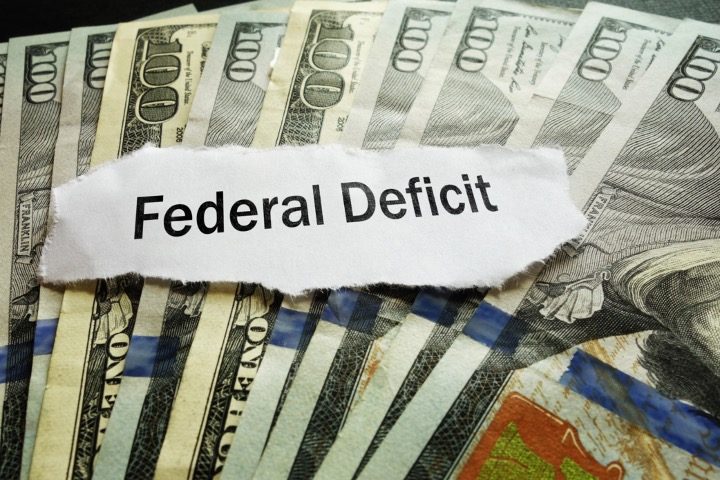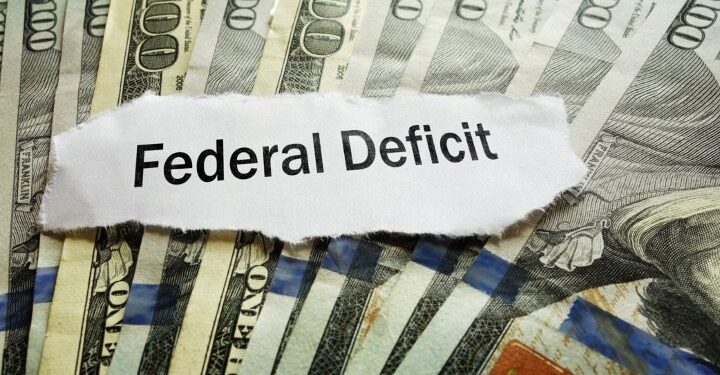
The U.S. Government Accountability Office calls the U.S. government’s deficit spending “unsustainable” and says it poses “serious” challenges to the nation’s economic and national security. The GAO wrote, “We have reviewed the government’s bookkeeping and continue to find weaknesses that undermine [the government’s] reliability.”
During last week’s annual Spring Meetings of the International Monetary Fund (IMF) and the World Bank held in Washington, D.C., officials were extraordinarily vocal in noting the continued deterioration of the United States from a fiscal standpoint.
Federal Reserve Chairman Jerome Powell kicked things off by suggesting that the Fed would continue to keep interest rates high in order to “temper” (i.e., slow down) an “overheated” American economy. He said nothing about the Fed’s role in creating that “overheated” economy through vast increases in the supply of money created to pay the government’s bills.
IMF Director Kristalina Georgieva also said that the U.S. economy was running too hot, while her deputy, Gita Gopinath, pointed to the America’s yawning budget deficit which has doubled in just the last year.
Even German Finance Minister Christian Lindner pointed out the supreme irony of Biden’s Inflation Reduction Act, which is causing more inflation rather than less.
The numbers are indeed mind-bending. Deficit spending last year (fiscal years run from October to September) hit $1.7 trillion, or more than six percent of the country’s total gross domestic product (GDP). For the first six months of the 2024 fiscal year, the deficit is now over $1 trillion and, if extended through this coming September, will likely hit $2 trillion for the year. In any event, this will be the fifth consecutive year in which the U.S. government deficit exceeds one trillion dollars.
Comptroller of the United States Gene Dodaro said, “Congress and the [Biden] administration must act to move the nation off the untenable long-term fiscal course on which it is currently.”
JPMorgan CEO Jamie Dimon wrote in his annual shareholder letter, “We may be entering one of the most treacherous geopolitical eras since World War II,” and suggested that interest rates to service the burgeoning national debt could rise from the current level of five percent to eight percent “or even more.”
As interest rates rise, the economy slows. As the economy slows, tax revenues decrease. That means that the ability of the economy to service just the interest charges on that $34 trillion of debt decline. At present, according to the Committee for a Responsible Federal Budget, “This year 39 cents of every dollar paid in individual income taxes is needed to simply pay interest on the national debt. That means we are paying for the past, not the future.”
And yet the three credit rating agencies that monitor the fiscal condition of the country remain persuaded that it deserves its highest (or next to highest) credit rating. Said Fitch Ratings on March 1:
The U.S. sovereign rating is supported by structural strengths that include the size of the economy, high per capita income and a dynamic business environment.
The U.S. benefits from issuing the U.S. dollar, the world’s pre-eminent reserve currency, and from the associated extraordinary financing flexibility.
That was the headline. Here is the rest of the story from Fitch:
The ratings are counterbalanced by its high fiscal deficits, interest burden and government debt that are all well over two times the ‘AA’ medians.
Additionally, standards of governance in the U.S. have steadily fallen over the last two decades while political polarization has risen, complicating the budget appropriations process with periodic brinkmanship over the debt limit and government shutdowns.
These governance issues hold back the implementation of a credible medium-term consolidation plan for the country’s public finances.
For instance:
Despite a last-minute deal reached in June 2023 to suspend the debt limit until the end of 2024, none of the FY24 appropriations bills were finalized by the Sept. 30 deadline.
Instead, Congress has relied on three separate continuing resolution agreements to keep the government open through March 2024, five months into the 2024 fiscal year.
In addition:
A complex budgeting process has contributed to the repeated episodes of political brinkmanship surrounding the debt limit and threats of government shutdowns.
Additionally, the lack of a fiscal anchor has hindered progress in tackling medium-term challenges emanating from the rising costs due to an aging population of mandatory spending programs such as social security and Medicare.
Shop For Night Vision | See more…
Shop For Survival Gear | See more…
-
Sale!

Tactical Camo Nylon Body Armor Hunting Vest With Pouch
Original price was: $49.99.$39.99Current price is: $39.99. Select options This product has multiple variants. The options may be chosen on the product page -
Sale!

Stainless Steel Survival Climbing Claw Carabiner Multitool Folding Grappling Hook
Original price was: $19.99.$9.99Current price is: $9.99. Add to cart -
Sale!

Mesh Shooting Hunting Vest with Multi Pockets
Original price was: $59.99.$39.99Current price is: $39.99. Add to cart

































 Reaction & Commentary
Reaction & Commentary












